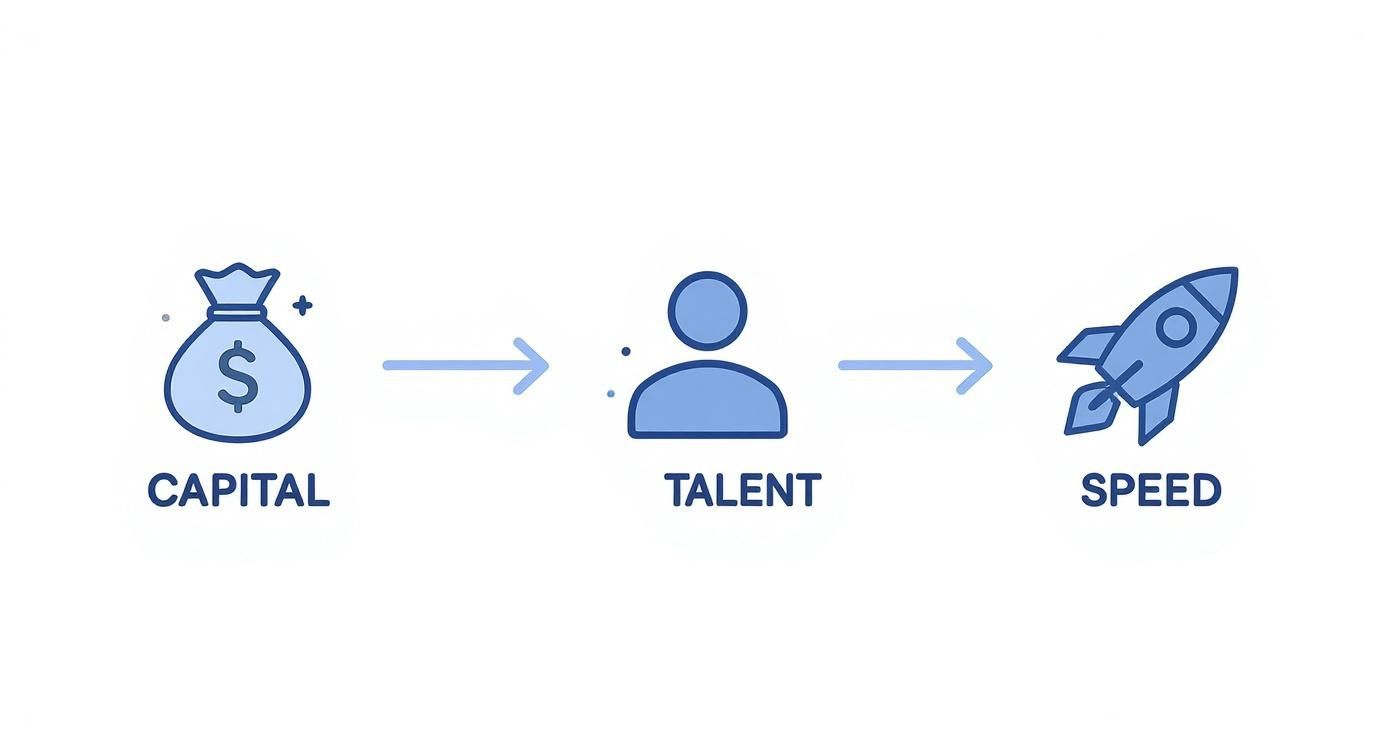What Is Equity Dilution for Founders
What Is Equity Dilution for Founders – Ever heard the term equity dilution? It’s a phrase that can sound a bit intimidating, but the concept is pretty straightforward. In short, it’s what happens to your ownership percentage when your company issues new shares.
For a founder, this is a critical idea to get your head around. Even if the number of shares you personally hold never changes, your slice of the company pie gets smaller every time new investors or employees get their own piece.
The Pizza Analogy: A Simple Way to Understand Dilution

Imagine your new business is a freshly baked pizza. When you start, you own the entire thing—all eight slices. That’s 100% ownership. Simple.
But to grow, you need cash for things like marketing or new equipment. An investor comes along and agrees to give you the money you need, but in return, they want a piece of the action. Instead of handing over some of your own slices, you decide to make the pizza bigger. You add two brand-new slices and give them to the investor.
The pizza now has ten slices in total. You still have your original eight, but here’s the crucial bit: your ownership has changed. Your eight slices no longer represent 100% of the pizza; they now make up 80% (8 out of 10). That drop from 100% to 80%? That’s equity dilution in a nutshell.
Grasping the Core Trade-Off
At first, owning a smaller percentage feels like a loss. But think about what that investor’s cash can do. It could help you buy a better oven, source premium ingredients, and run ads that turn your local pizza joint into a regional chain. The whole pizza becomes much, much more valuable.
The big idea behind accepting dilution is this trade-off: it’s far better to own a smaller percentage of a huge, valuable company than to own 100% of a small one with no room to grow.
This principle is at the heart of what equity dilution means for a startup. It’s not a setback; it’s a strategic move to fuel growth and increase the value of the shares you do have.
Key Terms You Need to Know
To get comfortable with these conversations, there are two terms you’ll hear all the time:
- Shares Outstanding: This is simply the total number of shares a company has issued. In our pizza story, this started at eight slices and grew to ten after the investment.
- Ownership Percentage: This is your slice of the pie. You calculate it by dividing the number of shares you own by the total shares outstanding.
This isn’t just a startup phenomenon; it happens in big public markets too. In the UK, for example, domestic ownership of UK-listed companies fell from 96% in 1981 to just 42% by 2022. This was partly driven by companies issuing new shares and bringing in foreign investors. You can find more insights on UK equity trends from the London Stock Exchange Group.
Ultimately, while your percentage stake goes down, the goal is for the value of your remaining shares to shoot up, making your smaller slice worth far more than your original whole pizza ever could have been.
Why Dilution Is a Necessary Part of Startup Growth
While our pizza analogy makes dilution easy to grasp, it begs an obvious question: why would any founder willingly give up a slice of their company? The answer is simple. Growth needs fuel, and for a young business, that fuel usually comes in the form of capital and talent it doesn’t yet have.
Giving up equity is rarely about losing something. It’s about making a strategic trade—swapping a percentage of ownership for the resources needed to build something far bigger and more valuable. Founders choose this path because it unlocks opportunities that would otherwise be completely out of reach. It’s a fundamental part of the journey when you start to learn how to scale a business effectively.
Securing Capital Through Funding Rounds
The most common reason for dilution is simply raising money. A brilliant idea can only take you so far. To turn that idea into a real, market-ready product, you need cash for development, marketing, operations, and hiring the right people.
This capital is usually raised in stages, known as funding rounds (like Seed, Series A, Series B), and each round brings in new investors who receive newly created shares.
- Practical Example: A Seed Round. A fintech startup wants to build an app but needs £150,000 for development and regulatory approvals. A founder with 100% ownership finds an angel investor. They agree on a £600,000 pre-money valuation. The company issues new shares to the investor for their £150,000, giving them a 20% stake (£150k is 20% of the new £750k post-money valuation). The founder is diluted to 80% but now has the capital to build the product.
This dynamic is happening all over the UK. In 2021 alone, UK small businesses attracted a staggering £18.1 billion in equity investment across 2,616 deals. This flood of capital, from both local and overseas investors, shows just how essential outside funding is for growth—even if it means founders have to dilute their stake. You can dig into more data on these trends from the British Business Bank.
Attracting Top Talent with Share Options
In a competitive market, early-stage startups often can’t go head-to-head with the salaries offered by big, established companies. So, what’s their secret weapon? Equity. By setting up an Employee Share Option Pool (ESOP), founders can offer talented people the chance to own a piece of the company they’re helping to build.
An ESOP is simply a slice of company equity set aside for future hires. When these options are granted and later exercised, they turn into real shares. This, of course, dilutes the ownership of all existing shareholders, including the founders themselves.
Dilution from an ESOP isn’t a loss; it’s a strategic investment in people. Offering equity aligns an employee’s goals with the company’s long-term success, turning them from just an employee into a committed co-owner.
- Practical Example: An ESOP in Action. A founder wants to hire a star software developer who has offers from much larger tech firms. The startup can’t match their salary offers, but it can offer share options from a newly created 10% ESOP. The potential for a huge financial upside convinces the developer to join, bringing skills that accelerate product development and make the whole company more valuable. For the founder, creating this 10% pool means their 80% stake is diluted to 72% (90% of 80%), but they’ve secured a critical team member.
Gaining Speed with Convertible Instruments
Sometimes, a startup needs cash fast, without going through the long, complex process of a priced funding round. This is where convertible instruments come in. Things like SAFEs (Simple Agreements for Future Equity) or convertible notes allow an investor to provide capital now in exchange for the right to get equity later.
This approach lets founders close funding rounds much more quickly, but it creates dilution down the road. When the next official funding round happens, the money from the convertible instrument converts into shares—usually at a discount—which dilutes the existing shareholders even more.
- Practical Example: A Convertible Note. A startup is running low on cash but is close to landing a huge contract. They need £50,000 to tide them over for three months. They sign a convertible note with an investor for £50,000. Six months later, they raise a proper Series A funding round. The £50,000 from the note converts into shares at that new valuation, but with a 20% discount as a reward for the early risk. This causes slightly more dilution than if the investor had participated in the round directly, but the immediate cash injection was vital for survival.
How to Calculate Equity Dilution with Real Examples
Theory is one thing, but seeing the numbers in action makes it all click. To really get your head around what is equity dilution, we need to roll up our sleeves and walk through the calculations step-by-step. Let’s follow the journey of a fictional startup, ‘InnovateUK Ltd.’, to see exactly how a founder’s stake changes over time.
We’ll track our solo founder, Sarah, right from the beginning, through a crucial Seed round and then a Series A round. This will show you not just how dilution happens, but more importantly, how the value of her remaining slice of the pie can grow massively.
Stage 1: The Founder’s Starting Position
Meet Sarah, the founder of InnovateUK Ltd. On day one, she’s the only one in the picture. She issues herself 1,000,000 shares, meaning she owns 100% of the company.
The initial capitalisation table (or ‘cap table’) is as simple as it gets:
| Shareholder | Shares | Ownership |
|---|---|---|
| Sarah (Founder) | 1,000,000 | 100% |
| Total | 1,000,000 | 100% |
At this point, there’s no outside money and no other shareholders. Sarah has total control. But to get her idea off the ground and hire a team, she needs capital.
Stage 2: The Seed Funding Round
InnovateUK Ltd. needs £250,000 to build its first product. Sarah finds an angel investor who’s keen to back her vision. After some negotiation, they settle on a £1,000,000 pre-money valuation – that’s the company’s value before the new cash comes in.
Here’s how the maths breaks down:
- Find the post-money valuation: This is simply the pre-money value plus the new investment.
- £1,000,000 (Pre-Money) + £250,000 (Investment) = £1,250,000 (Post-Money Valuation)
- Work out the investor’s ownership: Divide the investment by the post-money valuation.
- £250,000 / £1,250,000 = 20%
- Calculate the share price: Take the pre-money valuation and divide it by the existing shares.
- £1,000,000 / 1,000,000 shares = £1.00 per share
- Figure out how many new shares to issue: Divide the investment amount by the new share price.
- £250,000 / £1.00 per share = 250,000 new shares
Suddenly, the cap table looks a lot different. The total share count has grown to 1,250,000.
| Shareholder | Shares | Ownership | Value of Stake |
|---|---|---|---|
| Sarah (Founder) | 1,000,000 | 80% | £1,000,000 |
| Angel Investor | 250,000 | 20% | £250,000 |
| Total | 1,250,000 | 100% | £1,250,000 |
You can see Sarah’s ownership has been diluted from 100% down to 80%. But look at the value of her stake – it’s now worth £1,000,000 on paper. This is the classic “smaller slice of a much bigger pie” scenario in action.
Stage 3: The Series A Funding Round
Fast forward a year, and InnovateUK Ltd. is flying. The product is out, customers are signing up, and it’s time to scale. Sarah needs a much bigger investment – £2,000,000 – to pour into sales and marketing.
A venture capital (VC) firm steps in to lead a Series A round, agreeing to an £8,000,000 pre-money valuation. The company’s value has shot up, proving the seed funding did its job.
Let’s run the numbers one more time:
- Calculate the new post-money valuation:
- £8,000,000 (Pre-Money) + £2,000,000 (Investment) = £10,000,000 (Post-Money Valuation)
- Determine the VC’s ownership stake:
- £2,000,000 / £10,000,000 = 20%
- Find the new Series A share price: We use the new pre-money valuation and the total shares outstanding before this round.
- £8,000,000 / 1,250,000 shares = £6.40 per share
- Calculate new shares for the VC firm:
- £2,000,000 / £6.40 per share = 312,500 new shares
The total number of shares has now jumped to 1,562,500 (that’s the old 1,250,000 plus the new 312,500).
This handy visual shows how strategic dilution fuels growth by injecting capital, attracting talent, and speeding up development.

As the infographic makes clear, dilution isn’t just a financial transaction; it’s a strategic move to build a more valuable and competitive company.
To see the full picture, let’s track how Sarah’s stake has evolved across both funding rounds.
InnovateUK Ltd Cap Table Evolution: Seed vs Series A
The table below breaks down the impact on Sarah’s ownership at each stage. It shows her share count remaining the same, but her percentage ownership decreasing as new shares are created for investors.
| Shareholder | Shares (Pre-Seed) | % Ownership (Pre-Seed) | Shares (Post-Seed) | % Ownership (Post-Seed) | Shares (Post-Series A) | % Ownership (Post-Series A) |
|---|---|---|---|---|---|---|
| Sarah (Founder) | 1,000,000 | 100% | 1,000,000 | 80% | 1,000,000 | 64% |
| Angel Investor | 0 | 0% | 250,000 | 20% | 250,000 | 16% |
| VC Firm | 0 | 0% | 0 | 0% | 312,500 | 20% |
| Total Shares | 1,000,000 | 100% | 1,250,000 | 100% | 1,562,500 | 100% |
After the Series A round, Sarah’s ownership is down to 64%. The angel investor who came in at the seed stage has also been diluted, dropping from 20% to 16%.
So, was it worth it? Let’s look at the value.
The Power of Smart Dilution: Sarah’s ownership dropped from 100% to 80%, and now to 64%. But the paper value of her stake skyrocketed from zero to £1,000,000, and now to an incredible £6,400,000 (64% of the £10m valuation).
This journey perfectly illustrates why founders embrace dilution. Each funding round shrinks your percentage, but if the capital is used well to grow the company’s valuation, the financial outcome for everyone involved gets much, much bigger. With these calculations in your toolkit, you can better understand your own cap table and make informed decisions for your company’s future.
The Human Impact of Dilution on Your Team
While cap tables and spreadsheets show you the maths, they don’t capture the full story. Equity dilution is far more than just numbers on a page; it’s a deeply human process that affects the psychology, motivation, and relationships of everyone pouring their heart and soul into building a company.
To really understand what is equity dilution, you need to appreciate its impact on the very people turning your vision into reality. Each stakeholder experiences this journey differently, navigating a complex trade-off between their personal ownership and the company’s collective growth.
The Founder’s Shifting Role
For a founder, the first few rounds of dilution can be a profound psychological adjustment. It marks the transition from being the sole owner of an idea to becoming the steward of a business with multiple stakeholders who now have a say.
Losing majority control is often the biggest milestone. Suddenly, decisions that were once yours alone now require board approval and investor consensus. This isn’t a failure—it’s a clear sign of success and growth—but it demands a huge change in mindset. You shift from visionary to collaborator.
The weight of responsibility grows, but direct control lessens. It’s also at this stage that founders truly learn the importance of choosing the right partners, a topic we explore in our guide on how to find business partners.
The founder’s journey through dilution is a gradual shift from “my company” to “our company.” It tests your ability to trust others with your vision and to lead through influence rather than direct authority.
This shift can be tough, but successful founders learn to embrace it. They recognise that bringing in experienced investors and talented employees with skin in the game makes the entire enterprise stronger and more resilient.
The Employee Perspective on Stock Options
For employees who join a startup for the promise of equity, dilution is a critical factor in their potential financial outcome. An offer of 10,000 stock options might sound fantastic, but its real value is tied to both the company’s future valuation and the effects of dilution.
Employees must understand that their initial grant represents a percentage of the company at that moment. As new funding rounds happen, that percentage will inevitably shrink.
- Valuation Matters More: An employee’s focus should be less on the raw number of options and more on the company’s potential for growth. Owning 0.1% of a company that becomes worth £100 million is far more valuable than owning 1% of a business that stagnates at £1 million.
- Transparency is Key: Founders who openly communicate about funding rounds and explain how dilution impacts the option pool build enormous trust. When employees understand the “smaller slice of a much bigger pie” logic, they stay motivated and aligned with the company’s long-term goals.
This dynamic shows why a healthy growth trajectory, fuelled by investment, ultimately benefits everyone, even as their individual ownership percentages decrease.
The Early Investor’s Long Game
Angel investors and early backers are the first to take a significant risk on a founder’s vision. They go in knowing their initial stake will almost certainly be diluted over subsequent, larger funding rounds. It’s part of the deal.
Their perspective is all about calculated risk. They know their initial 20% seed-stage ownership might shrink to 5% or even less by the time the company is ready for an exit. Their success depends entirely on that 5% being worth exponentially more than their original investment.
This is a long game, and it’s why dilution is an accepted—and necessary—part of the startup lifecycle for them. It’s a sign that the company is succeeding and attracting the serious capital it needs to scale up and win.
Smart Ways to Manage and Minimise Dilution
Equity dilution is simply part of the startup journey. You can’t avoid it, but it’s definitely not something that just happens to you. As a founder, you can—and should—actively manage the process, protect your stake, and make sure every percentage point you give away brings maximum value in return. It’s about being proactive, not reactive.
Think of it as navigating a river. You can’t stop the current, but with the right tools and a clear map, you can steer your boat effectively. These strategies are your toolkit for having smarter, more confident conversations with investors and making dilution work for you, not against you.
Raise Capital in Stages
One of the most powerful ways to manage dilution is to avoid raising more money than you absolutely need at any one time. Early-stage capital is always the most “expensive” because your company’s valuation is at its lowest. Giving up 20% of your company for £250,000 in a Seed round is far more punishing than giving up 5% for that same amount a few years later when your valuation has shot up.
The smartest approach is staged financing, where you raise just enough cash to hit your next major milestone.
- Seed Round: Get enough to build your minimum viable product (MVP) and win over your first handful of customers.
- Series A: Once you have product-market fit, raise what you need to pour fuel on your sales and marketing fire.
By tying your fundraising to specific, achievable goals, you can justify a higher valuation at each round. This means you give up less equity for every pound raised, which is the key to minimising dilution over the long term.
Negotiate Anti-Dilution Provisions
When you’re sat across the table from investors, certain clauses in your term sheet can protect you from getting hammered by dilution, especially in a “down round”—that dreaded scenario where you raise money at a lower valuation than before. These lifesavers are called anti-dilution provisions.
Anti-dilution provisions are basically an insurance policy for early investors. They adjust an investor’s ownership stake to protect its value if the company’s valuation drops in a future funding round.
There are two main flavours, and you need to know the difference:
- Full Ratchet: This is the harshest and most founder-unfriendly version out there. It reprices all of the early investors’ shares to the new, lower price of the down round. For founders and other shareholders, this can be brutally dilutive. Avoid it if you can.
- Weighted Average: This is a much more common and balanced approach. It adjusts the conversion price for early investors using a formula that takes into account both the old and new share prices, plus the number of new shares being issued. It offers protection without being overly punitive.
Always, always push for a weighted-average clause. It’s the industry standard and signals that you know how to protect your own equity while still being fair to your investors. This is a critical detail that needs to be formalised. Using a solid framework like a free shareholder agreement template from the start can make sure these terms are crystal clear.
Be Smart About Your Option Pool Timing
Creating an employee share option pool (ESOP) is non-negotiable for attracting top talent, but when you create or expand it matters immensely. Investors will almost always insist that the ESOP is created or topped up as part of their investment, and they’ll want it done using the pre-money valuation.
This is a crucial detail. If the option pool comes out of the pre-money share total, only the existing shareholders (that’s you, the founder) get diluted. If it’s created post-money, the new investors are diluted right along with everyone else.
Here’s a practical example: An investor agrees to a £4 million pre-money valuation and wants a 10% option pool set up for new hires. If this is done “pre-money”, the company creates the 10% pool first, effectively reducing the founder’s ownership before the investment cash comes in. The founder’s stake takes the entire hit of this dilution. You should always negotiate to keep this pre-money option pool as small as is realistic, justifying its size with a clear hiring plan for the next 12-18 months. Don’t create a bigger pool than you need just to keep an investor happy.
Common Questions About Equity Dilution
As founders and early employees get to grips with equity, a few questions seem to pop up time and time again. Understanding the theory of dilution is one thing, but figuring out how it applies in the real world can feel a bit abstract. Here are some clear, straightforward answers to the most common sticking points.
How Does My First Investment Cause Dilution When I Am The Only Owner?
This is a classic and completely logical question. If you own 100% of the company, how can an investor get a piece without you physically giving them some of your shares?
The key is to remember that you’re not handing over your existing shares; the company is creating brand-new ones just for the investor.
Imagine your company has 1,000,000 shares, and you own all of them. To raise money, the company authorises and issues 250,000 new shares and sells them to an investor. You still hold your original 1,000,000 shares, but the total number of shares in existence (the ‘shares outstanding’) has just increased to 1,250,000.
Your ownership is now your shares divided by this new, larger total (1,000,000 / 1,250,000), which means your stake is 80%. The dilution happened because the total size of the pie grew, not because your slice was cut down.
What Is The Difference Between Economic and Voting Dilution?
While they’re often linked, economic and voting dilution are two different things, affecting separate aspects of your role in the business. It’s vital to understand both.
- Economic Dilution: This is all about the money. It’s the reduction in your financial ownership percentage, which directly impacts your share of future profits or the proceeds from a sale. Every time new shares are issued, your economic stake gets a little smaller.
- Voting Dilution: This is about your influence and control. If each share gets one vote, issuing new shares reduces your percentage of the total voting power. This can affect your ability to pass resolutions, appoint directors, or approve big strategic decisions.
It’s possible to have one without the other. For instance, a company could issue non-voting shares to new investors. This would cause economic dilution for existing shareholders but wouldn’t touch their voting control.
How Do Convertible Notes Affect Dilution Compared to a Priced Round?
Convertible notes (and their close cousins, SAFEs) are hugely popular for early-stage funding because they’re faster and simpler than a traditional priced round. But they handle dilution very differently.
A priced round, like a Series A, causes immediate and clear dilution. You and your investors agree on a company valuation, set a share price, and issue a specific number of new shares. The dilution is calculated and locked in the moment the deal closes. Simple.
A convertible note, on the other hand, is essentially a loan that turns into equity at a future funding round. This means it defers the dilution. You get the cash now, but you won’t know the exact dilution impact until that note converts down the line. To reward the early investor for their risk, the note usually converts at a discount to the future share price, which means the eventual dilution is slightly greater for you than it is for the new investors in that later round.
Can I Avoid Dilution Completely if My Business Is Profitable?
Yes, absolutely—but it comes with some serious trade-offs. A business that funds its growth entirely from its own profits is known as a bootstrapped company. By never taking external equity investment, the founders can retain 100% ownership and avoid dilution completely.
However, this path isn’t for everyone. Bootstrapping almost always means slower growth. When you rely solely on profits, you limit your ability to make big, aggressive moves in marketing, hiring, or product development. Meanwhile, your competitors who are taking on investment and diluting their equity could use that capital to scale much faster and capture the market.
Ultimately, the choice comes down to your personal goals. If maintaining total control and ownership is your absolute top priority, bootstrapping is the way to go. But if your ambition is to build a large, market-leading company as quickly as possible, then strategic equity dilution is almost always a necessary part of the journey.
Navigating the complexities of equity, ownership, and business growth can be challenging. At Grow My Acorn, we provide the information, help, and advice that entrepreneurs and company directors need to make informed decisions. Explore our resources to build your business with confidence at https://growmyacorn.co.uk.











































